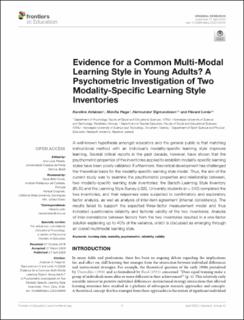| dc.contributor.author | Aslaksen, Karoline | |
| dc.contributor.author | Haga, Monika | |
| dc.contributor.author | Sigmundsson, Hermundur | |
| dc.contributor.author | Lorås, Håvard | |
| dc.date.accessioned | 2020-11-04T11:55:47Z | |
| dc.date.available | 2020-11-04T11:55:47Z | |
| dc.date.created | 2020-03-27T15:15:02Z | |
| dc.date.issued | 2020 | |
| dc.identifier.issn | 2504-284X | |
| dc.identifier.uri | https://hdl.handle.net/11250/2686372 | |
| dc.description.abstract | A well-known hypothesis amongst educators and the general public is that matching instructional method with an individual’s modality-specific learning style improves learning. Several critical reports in the past decade, however, have shown that the psychometric properties of the inventories applied to establish modality-specific learning styles have been poorly validated. Furthermore, theoretical development has challenged the theoretical basis for the modality-specific learning style model. Thus, the aim of the current study was to examine the psychometric properties and relationship between, two modality-specific learning style inventories: the Barsch Learning Style Inventory (BLSI) and the Learning Style Survey (LSS). University students (n = 242) completed the two inventories, and their responses were subjected to confirmatory and exploratory factor analysis, as well as analysis of inter-item agreement (internal consistency). The results failed to support the expected three-factor measurement model and thus indicated questionable reliability and factorial validity of the two inventories. Analysis of inter-correlations between factors from the two inventories resulted in a one-factor solution explaining up to 40% of the variance, which is discussed as emerging through an overall multimodal learning style. | en_US |
| dc.language.iso | eng | en_US |
| dc.publisher | Frontiers Media | en_US |
| dc.rights | Navngivelse 4.0 Internasjonal | * |
| dc.rights.uri | http://creativecommons.org/licenses/by/4.0/deed.no | * |
| dc.title | Evidence for a common multi-modal learning style in young adults? A psychometric investigation of two modality-specific learning style inventories | en_US |
| dc.type | Peer reviewed | en_US |
| dc.type | Journal article | en_US |
| dc.description.version | publishedVersion | en_US |
| dc.source.volume | 5 | en_US |
| dc.source.journal | Frontiers in Education | en_US |
| dc.identifier.doi | https://doi.org/10.3389/feduc.2020.00040 | |
| dc.identifier.cristin | 1803993 | |
| dc.description.localcode | Copyright © 2020 Aslaksen, Haga, Sigmundsson and Lorås. This is an open-access article distributed under the terms of the Creative Commons Attribution License (CC BY). The use, distribution or reproduction in other forums is permitted, provided the original author(s) and the copyright owner(s) are credited and that the original publication in this journal is cited, in accordance with accepted academic practice. No use, distribution or reproduction is permitted which does not comply with these terms. | en_US |
| cristin.ispublished | true | |
| cristin.fulltext | original | |
| cristin.qualitycode | 1 | |

